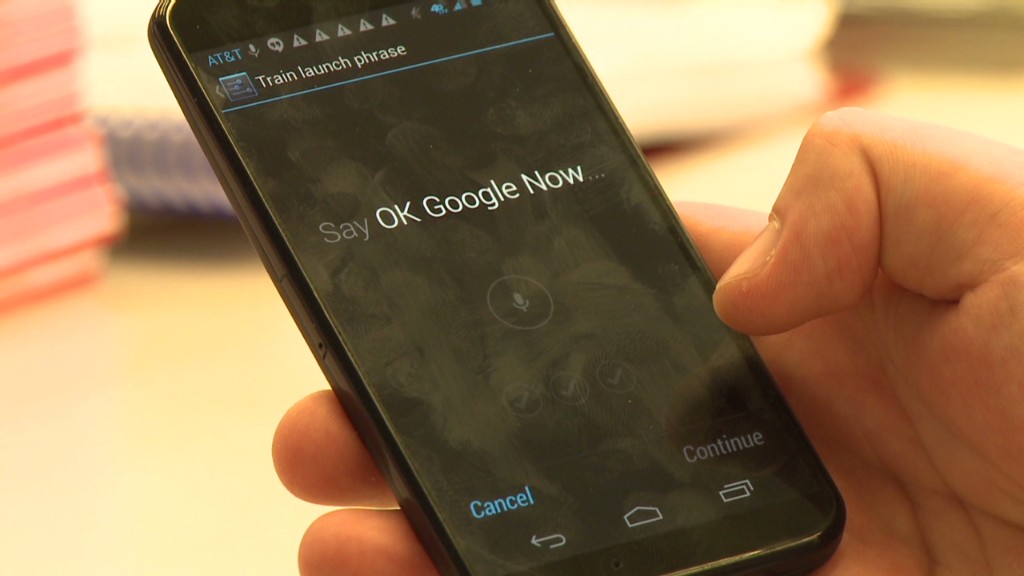
Google's new Moto X smartphone doesn't aim to be the fastest, biggest, or prettiest smartphone. It wants to be the smartest.
The search giant on Thursday unveiled the first smartphone of its own design since it bought struggling Motorola last year. Rather than go toe-to-toe with top-of-the-line smartphones, such as Apple's (AAPL) iPhone, Samsung's Galaxy S4 or HTC's One, Google (GOOG) designed the Moto X to make clever use of sensors and language processors to stay one step ahead of you.
The Moto X is built upon a chip called the X8, which allows the smartphone to understand natural language and gives it situational awareness. It's always listening for your command, whether it is sleeping or awake. And it knows where you're using it, and how you're using it.
By calling out "OK Google Now," you can place a call, map out a destination, log a reminder, or search on Google. The special language processing chip allows the phone to constantly wait for your voice to tell it what to do -- without you having to activate the microphone. Better yet, Motorola says that will have no detrimental effect on battery life.
Other wizardry: The display will automatically reveal the clock when you pick up the phone or pull it out of your pocket. Place your finger on the screen, and notifications pop up for your viewing. Let go, and it goes back to the default lock screen, quickly obscuring your communications from prying eyes.
Related story: Nexus 7 is the best Android tablet money can buy
When the phone is sleeping (or in any other state), twisting the phone like a screwdriver will allow you to open the camera with minimal fuss.
There's also a custom app called Assist that can use the Moto X's array of sensors to detect what sort of setting the phone is in and allow you to establish a group of settings that automatically kick in during these situations. For example, you can have all text messages read aloud to you while you drive. When you exit the car, that setting turns off.
It may emphasize sensors and smarts over power, but the Moto X is no slouch. It packs a 4.7-inch, 720p high-definition screen into a body not much bigger than an iPhone. It runs a relatively clean, bloatware-free version of Android, which means it's fast, excellent and will receive updates much quicker than a phone like the Galaxy S4. It has a 10-megapixel camera with a special-made sensor that devotes a quarter of each pixel to collecting extra light (a feature that could translate to more detailed photos without a flash).
And it has a battery that promises 24 hours on a single charge under "normal" use conditions. Yes, 24 hours.
The Moto X's hardware falls somewhere between the quality craftsmanship of the HTC One, and the plastic chintz of the Galaxy S4. It's definitely nice -- it's comfortable to hold and isn't too heavy -- but its polycarbonate plastic shell isn't so nice that it's an object of marvel in and of itself.
Perhaps the biggest ideas for the Moto X have little to do with technology: Users can log onto Motorola's website and customize the front, back and accent colors of the phone. A big reason why Motorola will be doing all the manufacturing for the Moto X in a Fort Worth, Texas factory was to be able to turn a custom order around in less than four days.
That feature, which is only available to AT&T (T) customers, for now, has little to do with technology and everything to do with marketing. For the Moto X's target audience, a general consumer audience less concerned with pixel density and camera sensors, Motorola's marketing plan might actually work. Google's money-losing Motorola division doesn't need a critically acclaimed phone, it needs a commercially successful one.
In the few hours I've had with the phone, the voice activated, contextual features were decent -- not terrible features. The only universal benefit over any other device is not having to tap one or two buttons before looking at notifications or offering up a voice command.
For a $200 phone that was hyped as heavily as the Moto X as the solution to our smartphone problems, it was hard to not expect a little more. In fact, all of the same special features were announced in Motorola's more utilitarian line of Droid phones last week.
The Moto X goes on sale at the end of August.

